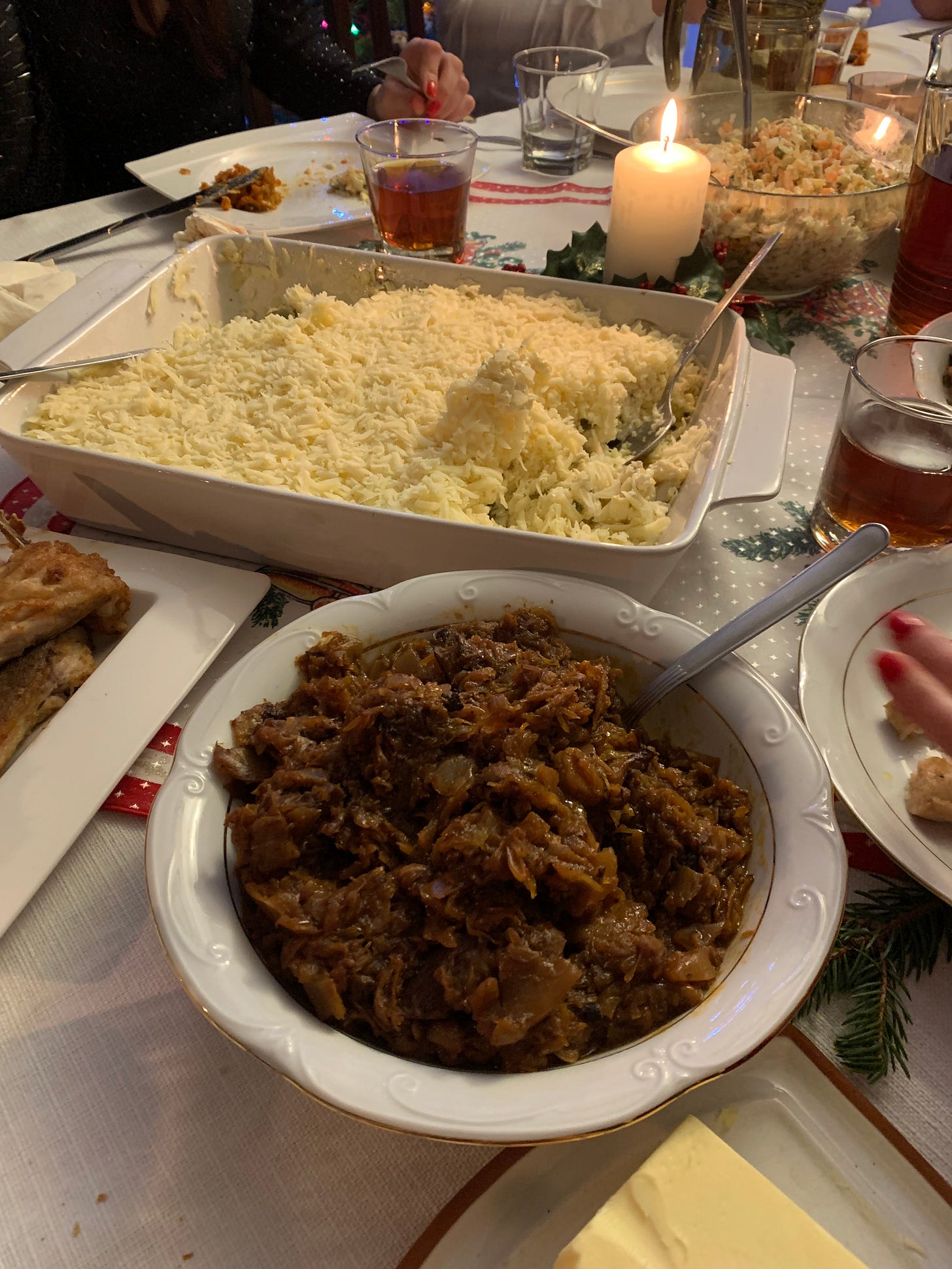Happy Twixmas! Christmas has come and gone, and if you're lucky enough to be off work this week, you're probably nestled at home under blankets with something warm and comforting to eat and drink, a book in hand or binging a new Netflix drama in this limbo time between Christmas and New Year's Eve.
I'm spending this time back home in Poland, making the most of it for much-needed rest and restoration, spending time with family, and, crucially, slowly digesting everything I ate over the holidays—which is a lot. Christmas in Poland is a big deal—it’s basically a three-day affair. In the UK, from what I gathered, Christmas Day is the main event, but in Poland (and much of Catholic Europe), celebrations begin on the 24th—Christmas Eve. But really, they begin at least two days before, as that's how long you need to prepare everything for the Christmas Eve supper. The food preparation in my house is actually my favourite part of Christmas. Everyone usually has a role to play, whether it's making a dish from start to finish or acting as the sous chef (that’s usually my dad’s role). He’s the one peeling heaps of beetroots, making the borscht soup base, and grinding the poppy seeds. There's a lot to do!
I mentioned everything I ate in this note, and today I really want to dive into one of the dishes I've been responsible for over the years: bigos. Like almost all the other dishes we eat for the Christmas Eve supper (which totals 12), bigos is only ever made for this occasion. At least, that’s how it is in my family. When I googled the English translation for bigos, I came across “Hunter’s Stew,” which makes sense. Essentially, bigos is a slow-cooked cabbage stew infused with the flavours of various meats and spices. As the English name suggests, it’s the kind of dish that would use whatever meat you could hunt for, and it’s the kind of dish that should be made in the largest pot available—one that could easily serve the whole village back in the day. The version I make certainly feeds 10+ guests and leaves plenty for days after Christmas.
As a kid, I used to love the traditional meaty version, but when I started experimenting with vegetarian and, later, vegan diets as a teenager, I couldn’t eat it anymore. It was a sad moment for me, and I needed to find an alternative that would still hit the spot. About six years ago, though, I came across a vegan bigos recipe that claimed to best replicate the original meaty taste, swapping meat for oyster mushrooms and using a whole array of spices and soy sauce to create that elusive umami flavour. In the first few years, I’d make a small pot just for myself and anyone else who wanted a plant-based option, but the meat version would still be made, just in case. Over the years, as I got better at making it, my family started warming up to the idea. Now, the vegan bigos has completely replaced the meat version and is devoured by everyone—even the die-hard meat eaters.


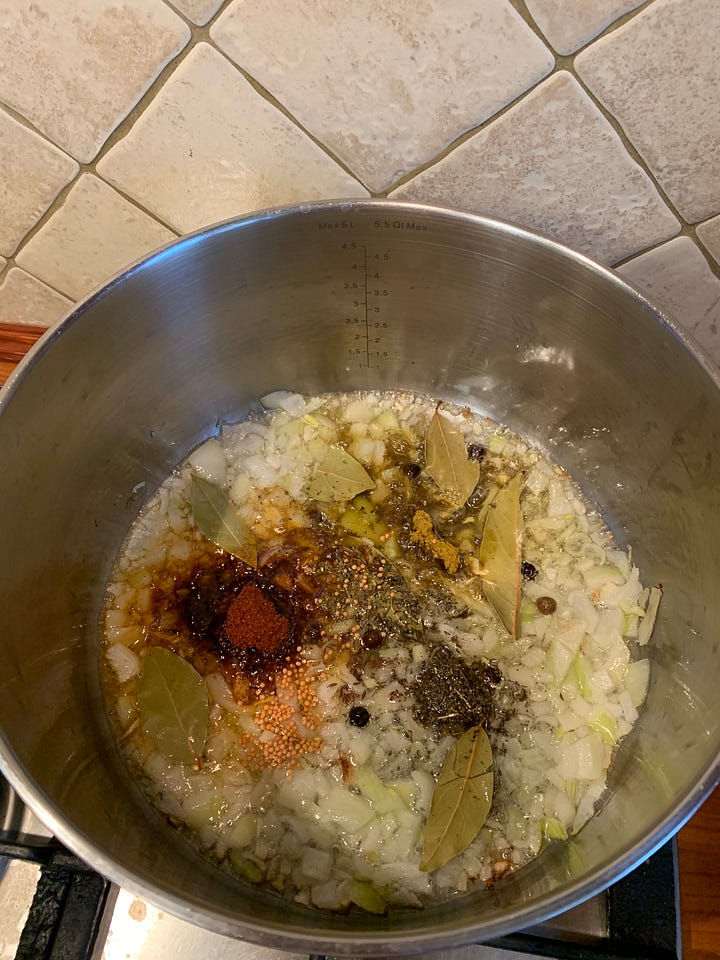
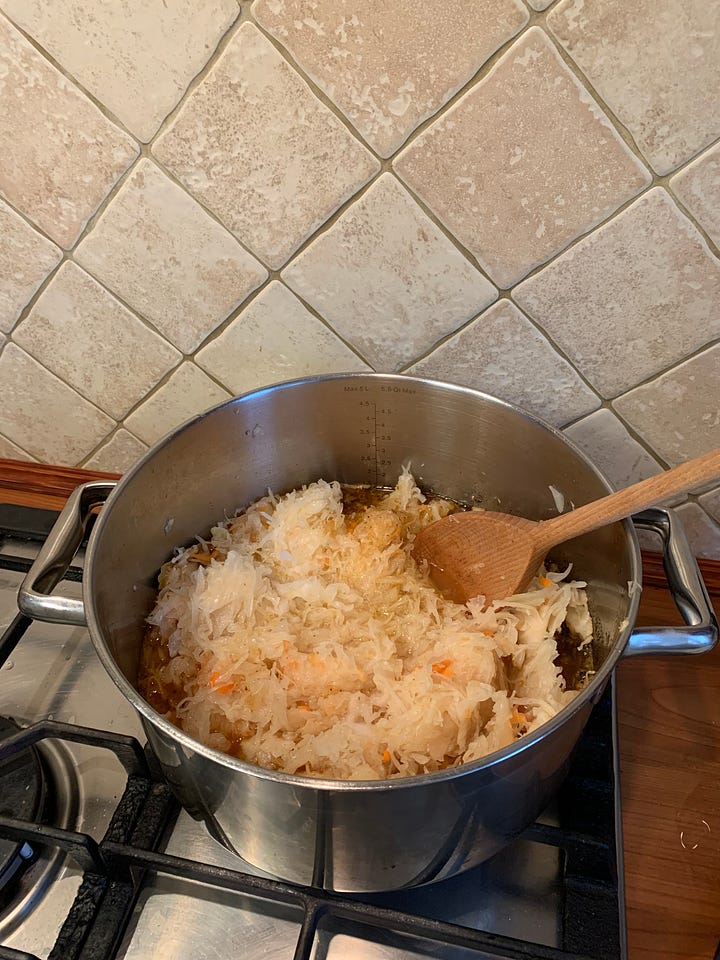
I can’t take any credit for this recipe, as it was created by the famous vegan Polish chef and blogger, Marta Dymek. On her blog Jadlonomia, she also provided an account of the origins of this iconic Polish stew, explaining how sauerkraut became an integral part of this traditionally meat-heavy dish:
The oldest preserved recipes for bigos date back to the 17th century and are not vegetarian in the slightest. Stanisław Czerniecki, the author of the first cookbook “Compendium ferculorum”, cites recipes for bigos with marrow or bigos with hazel grouse. Wojciech Wielądko, author of Kucharz Doskonaly from 1783, mentions equally meaty bigos. However, none of the authors mentions cabbage—bigos back then was a fatty goulash stew made of many different meats, with spices, wine, honey, and sour lemons, apples, or gooseberries. The idea for bigos with cabbage came from Lucyna Ćwierczakiewiczowa, the 19th-century Polish Nigella, who, in her famous cookbook “365 Dinners for Five Zlotys”, provided a recipe for bigos rogue with cabbage. It was only in this recipe that cabbage appeared alongside the meats, spices, and mushrooms. And that's where it all began!
There are many regional recipes for bigos with cabbage, so it’s hard to pinpoint the true version. There's bigos a la gypsy with tomatoes and hot peppers, Siebieborzański bigos with forest fruit, and even bigos with beetroot and beans. Some recipes call for white cabbage, others recommend using apples, and some swear by sauerkraut. Occasionally, it's seasoned with vodka, liqueur, or wine.
Bigos follows a similar technique to other famous stews like chilli con carne or beef stroganoff: you mix various ingredients and slow-cook them for hours, sometimes even days, to achieve a deep richness of flavour. The version I make, in addition to the traditional spices, has a hefty dose of smoked paprika, hot paprika, a spoonful of tomato paste, and—most importantly—golden-fried oyster mushrooms. This year, mine turned out a little more sour and spicy than I intended, so beware of adding too much wine and ensure it actually evaporates. Also, be sure to drain the sauerkraut well—these were likely my mistakes. Who knows. I’ll make it next year and inevitably it will turn out differently but just as good. It always does.
I usually start making the bigos a day or two before Christmas Eve. This is because there are always many other dishes to prepare, and we follow a strict cooking rota in our house. But you could easily start cooking it in the morning to have it ready for dinner; I just find bigos tastes best the next day. Making bigos is fairly easy, but it does require a lot of chopping and assembling all the needed ingredients in advance. Play a podcast and enjoy the process.
Bigos with oyster mushrooms
The original recipe was developed and published by Jadlonomia here.
Preparation time: 60 minutes + 4 hours of cooking
Ingredients
1 onion
4–6 tablespoons sunflower oil
1 kg sauerkraut (check your local Polish shop for the best quality)
2 cups water
1 tablespoon salt
1/2 cup green lentils (dry)
1 kg white cabbage
1 sour apple
1 cup water
1/2 cup dry red wine
1–3 tablespoons maple syrup or honey (I use honey)
1 tablespoon tomato paste
10 dried plums
1/4 cup dried cranberries
10g dried mushrooms
4 tablespoons soy sauce
Salt and coarsely ground black pepper to taste
Spices:
6 allspice berries
6 bay leaves
4 cloves
3 juniper berries
1 teaspoon cumin
1 1/2 teaspoons herbal pepper
1 1/2 teaspoons smoked paprika
1 1/2 teaspoons hot paprika
1 teaspoon savory
1 teaspoon marjoram
1/2 teaspoon thyme
1/2 teaspoon coriander seeds
1/2 teaspoon mustard seeds
For the oyster mushrooms:
500g oyster mushrooms
4 tablespoons sunflower oil
2 and 1/2 tablespoons soy sauce
1/2 teaspoon maple syrup or honey
Method
Chop the onion into large cubes and slice the sauerkraut into smaller pieces.
Heat a generous amount of oil in a very large pot, add the onion, and sauté for 1 minute. Then add all the spices and fry for another 2–3 minutes.
Add the sauerkraut, water, and salt to the pot, cover, and cook for 45 minutes.
Meanwhile, cook the lentils in lightly salted boiling water, chop the white cabbage, and grate the apple (with its skin).
Drain the cooked lentils. When the sauerkraut has softened, add the chopped cabbage, grated apple, and all remaining ingredients. Stir well, cover, and cook on low heat for 4 hours, stirring every hour. And that's the first part of the recipe done.

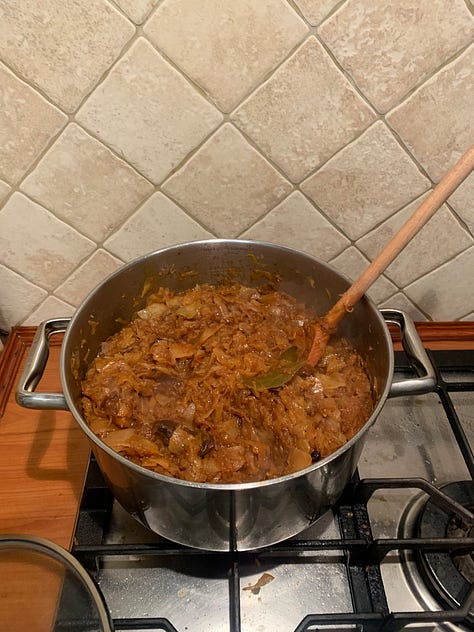
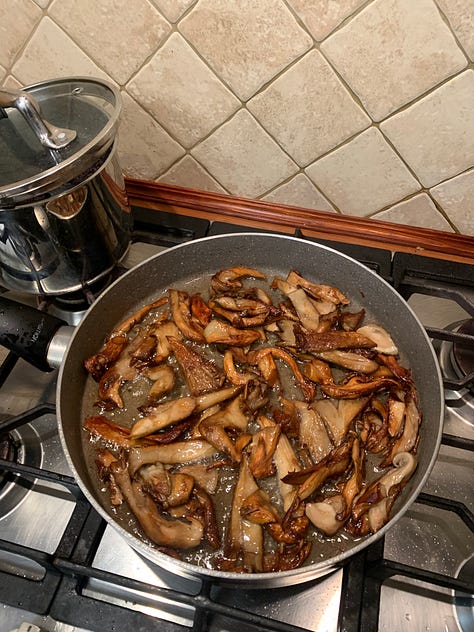
Before serving, prepare the oyster mushrooms. Cut them into thick strips. Heat oil in a large pan until it’s very hot, then add the mushrooms. Don’t stir right away—wait 1–2 minutes, then stir.
After another 2 minutes, stir again. Once the mushrooms are golden, pour in the soy sauce and honey, and stir until the liquid evaporates. Place the mushrooms on paper towels to drain.
Finally, season the bigos with salt and pepper and add more honey if needed. Stir in the fried oyster mushrooms.
Serve warm with bread and butter (optional) or potatoes (though never in my house).
Let me know how it turns out if you ever give this recipe a go!






